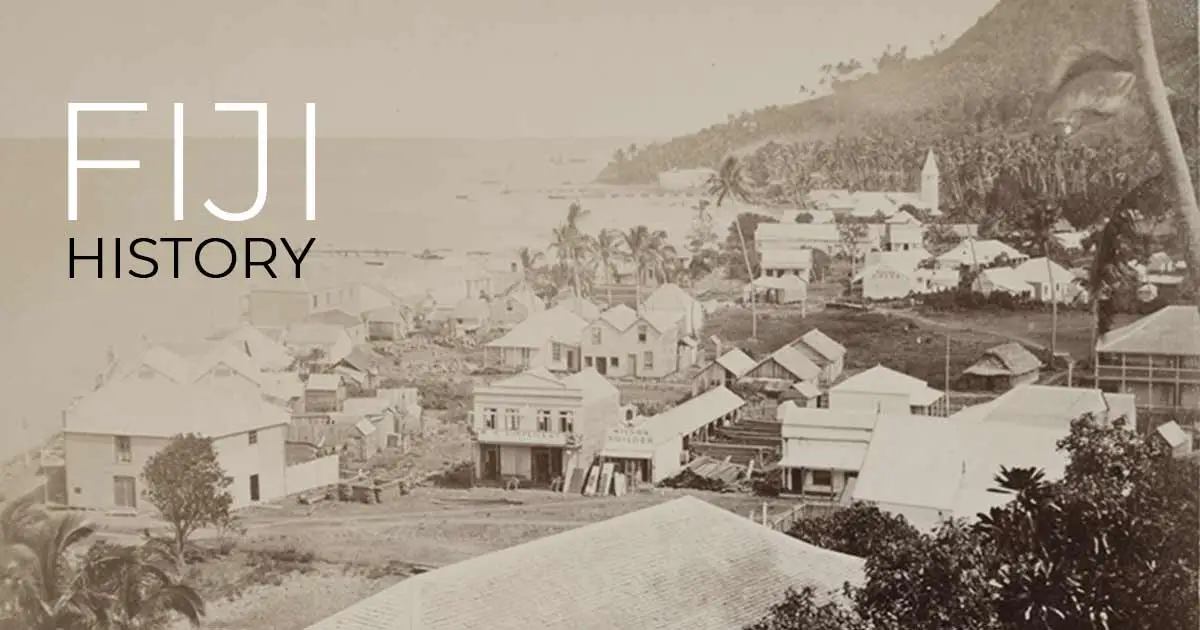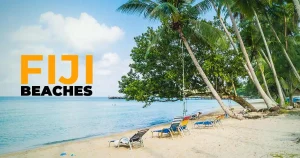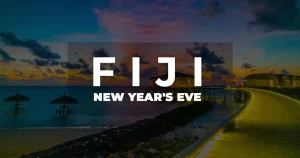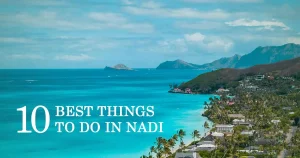Fiji is not just a tropical heaven of blue oceans and white sand beaches. Its story stretches across 3,000 years, a rich blend of indigenous traditions, colonial legacies, cultural fusion, and political transformation.
The Complete Guide to the History of Fiji is not just a timeline; it’s a story of waves, warriors, and wanderers. It begins with canoes slicing through the Pacific thousands of years ago and flows all the way to the modern Fiji of rugby heroes, golf courses, luxurious beaches, and resilient hearts. To understand Fiji is to travel through centuries of courage, collision, and coexistence, where ancient chants echo beneath colonial cathedrals, and where firewalkers now walk into a digital age.
The First People: Voyagers of the Blue Pacific
Long before Fiji appeared on any European map, the first people had already mastered its winds and waves. They were voyagers, brave explorers who crossed vast stretches of the Pacific in wooden canoes guided only by stars, ocean swells, and the flight of birds. Around 3,000 years ago, these Austronesian and Melanesian navigators reached the islands we now call Fiji, settling first on Viti Levu.
They not only carried tools and crops, but also stories, songs and a great respect for the rhythm of nature. Settlements were established along the coasts and river valleys, where the life of the village centred on the vanua, the sacred relationship that existed between the people, the land and the ancestors. Generations after generations, they created a vibrant community of skilled sailors, artisans, and warriors.
The ancient inhabitants of Fiji did not see the ocean as a barrier; it was their highway. They also got in touch with Tonga, Samoa, and further by the decks of their enormous, two-hulled canoes, creating a cultural tapestry that continues to define the Fijian identity even now. This sense of adventure and belonging is what makes Fiji, to this day, a nation of the sea.
The First Europeans: Sailors, Storms, and Stories
Centuries after the first Fijians settled their islands, new sails appeared on the horizon. In 1643, Dutch navigator Abel Tasman became the first European to glimpse Fiji, sighting the northern islands of Vanua Levu and Taveuni. More than a hundred years later, the great British explorer Captain James Cook passed by in 1774 and recorded one of the southernmost islands. But it was Captain William Bligh, adrift after the mutiny on the Bounty in 1789, who truly charted Fiji’s waters. His small boat drifted between Viti Levu and Vanua Levu, now called Bligh Water, as Fijian war canoes raced after him through stormy seas.
For many years after that, Fiji remained a place of fascination and fear. European sailors spoke of dangerous reefs and fierce warriors. Traders eventually followed, searching for sandalwood and sea cucumbers. With them came whiskey, guns, and the first touches of a changing world.
Those early encounters were brief but powerful. Across the open sea, two very different worlds met for the first time and began a story that would forever shape the islands of Fiji.
The Rise of Chiefs and the Birth of Power
With the increased trade and contacts, Fiji experienced increased internal strife over power. By the early nineteenth century, the tiny island of Bau, close to the eastern shores of Viti Levu, became the centre of power. High Chief Tanoa of Bau, with the help of a Swedish adventurer named Charlie Savage, gained access to guns and defeated rival clans, extending his control over much of western Fiji. After Tanoa’s reign, his son Ratu Seru Cakobau rose to power and became one of the most commanding figures in Fijian history. Meanwhile, Enele Ma‘afu, a Tongan chief, expanded influence in the east, bringing Methodist missionaries who began spreading Christianity.
The clash between faith and tradition sparked tension, including the 1867 killing of missionary Thomas Baker in the mountains. Though Cakobau’s rule later weakened, he became a symbol of Fiji’s first unity, a leader bridging tradition and modernity at a time of rapid change.
Fiji Becomes a British Colony
By the 1870s, Fiji stood at a crossroads. European planters had arrived in growing numbers, eager to build fortunes from cotton and sugar. In 1871, the Europeans established a short-lived national government and declared Cakobau the King of Fiji. But the situation only worsened. By 1874, exhausted by unrest and foreign pressure, Cakobau and other chiefs agreed to cede Fiji to Queen Victoria. The Deed of Cession was signed on October 10, 1874, in a small village near Levuka, marking the beginning of almost a century of British rule.
Sir Arthur Gordon was sent by Britain as the first governor, and he maintained the ownership of native land by the Great Council of Chiefs, but took Indian labourers under indenture to labour in the sugar fields. Since 1879, thousands of Indo-Fijians have come there, suffering but creating new communities. With time, Fiji was to become the land of two peoples, the Indigenous Fijians who preserved their traditions to the end, and the Indo-Fijians who originated the new civilisation out of the struggle and survival. Together, their stories would shape the heart of Fiji’s identity long after the empire was gone.
The Road to Independence
By the 1900s, Fiji was a colony divided by race and opportunity. Indo-Fijians sought equal rights while Indigenous chiefs remained loyal to Britain. World War II brought change. The Fijians participated in the war on the side of the Allies with courage, and after that, there was an awakening of critical consciousness and togetherness. The colonies across the Pacific were in search of freedom, and Fiji was not an exception. Party politics started emerging, with the National Federation Party (NFP), with representation that was mostly Indo-Fiji, and the Alliance Party under the leadership of Ratu Sir Kamisese Mara, representing Indigenous Fiji and Europeans.
By the 1960s, the push for self-government could no longer be ignored. Britain began preparing Fiji for independence, but there was a delicate balance to maintain, ensuring that Fijians retained their land and traditions while giving Indo-Fijians equal voice.
Fiji eventually got its independence on October 10, 1970, after several years of negotiations. The Union Jack came down, and a blue flag was hoisted up in the morning sun of Suva. Drums, bells, and cheers marked the birth of a new Pacific nation united by hope and heritage.
Coups, Challenges, and the Search for Unity
The independence of Fiji started with high hopes, but peace was temporary. Under the skin, the ancient hostilities between Indigenous Fijians and Indo-Fijians continued to boil. The issue of who really “owned” the nation, its land, power, and future would soon challenge the young democracy.
In 1987, only 17 years after independence, Fiji faced its first major political crisis, which led to its first military coup led by Sitiveni Rabuka, claiming to defend Indigenous interests. Then there was a second coup in the same year, and the nation was proclaimed a republic which ended formal relations with the British Crown. Most of the Indo-Fijians felt disillusioned and started to emigrate to Australia, New Zealand and Canada. Those who remained continued to contribute to the economy, especially through farming, business, and education, but deep mistrust lingered.
A new constitution was adopted in the 1990s that favoured the Indigenous Fijians; however, in 1997, a more inclusive version was adopted to restore balance. Hope came back, and Fiji was back in the Commonwealth. Yet peace remained fragile. In 2000, another coup erupted when gunmen invaded Parliament and held the Prime Minister, Mahendra Chaudhry, the first Indo-Fijian leader, hostage.
Political divisions continued with another coup in 2006, but Fijians survived the upheaval. There was silent power as farmers, teachers, and families restored their lives. Ultimately, the 2013 Constitution declared every citizen a “Fijian”, which fostered equality and national cohesion.
Modern Fiji: Healing, Resilience, and a Shared Future
After the turbulent years of coups and political unrest, Fiji has slowly found its balance. The ethnic lines that previously characterised the political landscape are slowly melting away as the younger generations adopt a national identity of respect, inclusivity and cultural pride. At the economic level, Fiji has become a regional centre of tourist attraction, trade and diplomacy.
Modern Fiji welcomes travelers from around the world with its natural beauty and warm spirit. Whether you’re chasing sunsets on the best beaches, scuba diving into coral gardens, or exploring Nadi’s top attractions, the islands promise adventure at every turn.
Fiji is on the frontline in climate advocacy, diplomacy and tourism, but has not lost any of the respect it has for the vanua, the land and spirit that unites its people. Still, challenges remain. Climate change is posing a threat to the coastal communities, and the migration process is still transforming the lives of families. However, every difficulty is taken with the same willpower with which the early explorers crossed the Pacific. The Fiji soul, the faith in vanua (the land, the people, and their relationship), lives on.
Conclusion: The Soul of Fiji
The complete guide to the history of Fiji is essentially a tale of survival, transformation and peace. From the earliest ocean voyagers to British colonisation, from the sugar plantations to independence and political struggle, each chapter tells of how the people could adjust to changes without losing their spirit.
The Fiji experience is not merely the survival process; it is a process of rediscovering unity in diversity, post-upheaval peace, and pride in the collective identity. Fiji makes the world remember that, even in a tiny island country, the waves of history may make something lasting and most human, where tradition and modernity walk hand in hand, and each new sunrise is a promise renewed. If you ever plan your own island adventure, consider Aries Rental to make exploring Fiji’s diverse landscapes smooth and stress-free.
Frequently Asked Questions (FAQs)
What is the brief history of Fiji?
Fiji’s 3,000-year history began with Pacific voyagers, followed by British colonisation in 1874, independence in 1970, and a path shaped by coups and reforms toward national unity.
Where do Fijians originally come from?
Fijians descended from Austronesian and Melanesian voyagers who settled on Viti Levu about 3,000 years ago.
Are Fijians black or Polynesian?
Indigenous Fijians are mainly Melanesian with some Polynesian influence, while modern Fiji is a diverse mix of Indigenous, Indo-Fijian, and other Pacific communities.
What are some important historical events in Fiji?
Some important historical events in Fiji include the arrival of the first settlers (c. 1000 BCE), European contact (1643–1789), British colonisation (1874), the arrival of Indian labourers (1879), independence (1970), and multiple coups (1987, 2000, 2006). The 2013 Constitution later marked a new era of equality and unity.
What is the old name for Fiji?
Before European contact, Tongans called the islands “Viti,” which the British later adapted to “Fiji.”





